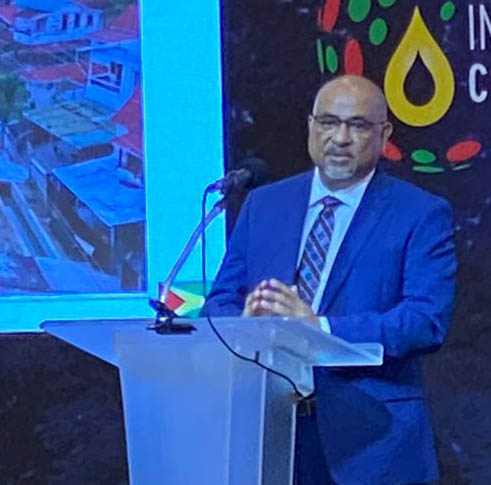Major works are soon to start on the CGX Energy Inc deepwater port in Berbice and the company’s Executive Chairman Dr Suresh Narine says that as Guyana seeks to strike a balance between preservation and development of its oil and gas sector some disruption to the environment has to be expected.
“If we want to see progress, we’ve got to disturb the environment somehow. But if we’re going to do that, we must disturb it as intelligently and as carefully as we can,” Dr Narine yesterday told the International Energy Conference at the Marriott Hotel.
He made the commitment while speaking to the company’s decision to retain 10 acres of old-growth mangroves on the plot of land for the construction of its deepwater port. No information was provided on any planned removal of mangroves in the area.
The deepwater port is being constructed aback Seawell Village, Corentyne, Berbice and the civil works are being carried out by the company’s subsidiary, Grand Canal Industrial Estates Inc (GCIE). The deepwater port facility will cost a total of US$80 million.
Dr Narine explained that the facility would sit on 30 acres of land and a Memorandum of Understanding (MoU) would soon be signed to retain 10 acres of mangroves on the plot. Pointing out that Berbice is known for its swamps and agricultural lands, Dr Narine said that when developing facilities, like the port, environmental considerations should be put in place. Nevertheless, he said that some environmental degradation is required in the furtherance of economic growth.
“…those (standing mangroves) are effectively going to be the source of an MOU that’s about to be signed, where we look at the coexistence of mangrove habitats with commercial activity on our rivers…through those 20 acres we have 400 meters of frontage,” he said.
Providing an update on the deepwater port, Dr Narine said that the construction of docks and dredging would begin very shortly while they are in the process of selecting the engineering, procurement and construction (EPC) contractors. He added that CGX is looking at its offshore supply component of the port to be completed during the latter part of this year. He had previously signalled operationalization by October 2022 but yesterday shied away from pinpointing a definitive date.
The port, itself, when completed is expected to have an offshore supply component that will provide essential support to offshore oil and gas operations.
The CGX executive told the conference that the idea of a deepwater port was envisioned in 2010 with Berbice being the ideal location. He said that the river has one of the deepest natural channels in the country and that was a major advantage with selecting the location.
“All the country’s rivers are gigantic sedimentation systems and those sedimentation systems are depositing our highlands into the Atlantic Ocean. This is very common of most of the major river systems in South America… force throws all of that sediment onto the western banks of the river resulting in all of the channels in this country being along the eastern bank (of the rivers),” he said.
He further explained that the port facility is to be located on the eastern bank of the Berbice River which is close to the channel and has resulted in minimal need to dredge to access the channel. Dr Narine said that the facility is far enough that it is away from built-up areas but close enough to be able to access the town of New Amsterdam in terms of hospitality, logistics, labour, facilities and services. Additionally, the facility’s location would ensure that it does not create encumbrances to the daily lives of citizens.
“The facility is about 12 and a half hours sailing to the Stabroek Block and so it offers quite natural advantages to, for example, accessing shore bases,” he added.
The CGX executive also talked up the impact of the port on agriculture in Berbice explaining that it poses the opportunity to eliminate the 20% surcharge that rice farmers would have to pay to transport paddy from the county to the ports in Georgetown.
“Part of … this port will be purpose-built to ensure that grains can be handled rapidly, safely and to be quality controlled at the port so that pricing can be done seamlessly. In addition, the port has advanced talks with a consortium in Roraima in Brazil. One of the shortest routes to the sea from Roraima is across into Guyana across the Berbice River and into the Berbice Coast,” he related.
Dr Narine further stated that CGX is building the port to facilitate the current capacity while adding that the design is such that it has the potential to expand as demands increase. (Lakhram Bhagirat)





